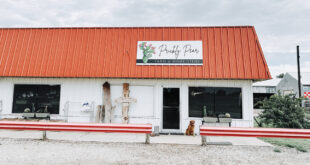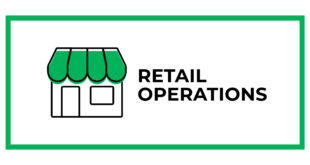Have you ever heard of CrossFit®? With more than 7,000 gyms in the U.S. and 13,000 worldwide, you probably know at least one person who participates in this group-focused fitness method, which has attracted a massive following of loyal members and has become an official sport. These athletes, called CrossFitters, are very vocal about how workouts are challenging, effective and best completed as a group, so, even if you don’t belong to the CrossFit community, you can quickly recognize that CrossFitters are loyal fans and cheerleaders for this brand.
Every one of these 13,000 gyms, or boxes according to CrossFit terminology, is unique. The staff at each box is licensed to train members using the CrossFit method, but that’s where the similarities end. Boxes are independently owned and run by different people in different towns with different customers, giving these businesses an opportunity to brand themselves to fit in with their communities.
As an independent home improvement retailer, there are a few lessons you can take away from CrossFit boxes. First, when people have a positive experience with your business, they become a loyal fan and will happily tell stories about their experiences to others. Second, even though the overall method and business model of each box is the same, they are all unique, which increases their brand loyalty with customers. If you operate under a co-op, this concept is likely very familiar to you.
While your co-op is part of your identity, having a brand that’s completely unique to your business is important to create loyal customers. “Brand” has become a word that means something different to everyone. What does it mean to have a brand? For some retailers, it means a store logo and a Facebook page. Others may take advantage of their wholesaler’s branding efforts. Both can be part of the equation, but building a strong brand for your business is about creating a story and an experience your customers want to engage with.
In this article, Hardware Retailing breaks down the fundamentals of establishing a brand and how the concept has changed. We also discuss why building relationships is a vital part of having a strong brand. Finally, we’ll help you define and design a brand that makes sense for your business.
What is a brand?
A brand is part object.
According to the American Marketing Association, a brand is a “name, term, design, symbol, or any other feature that identifies one seller’s good or service as distinct from those of other sellers.” With this description in mind, a brand is a concept that is applied to a company’s product or service. For example, the CrossFit brand is identified by its fitness method’s unique name, and at Starbucks, the brand is the logo you see on every cup.
A brand is part experience.
Beyond its basic definition, branding started to expand from being object-based to encompassing an entire customer experience. At CrossFit, members don’t come in and individually hit the treadmill or weights like a regular gym. Instead, they are actively engaged with others as they workout with a trainer and a team, and there is a corresponding lesson with the day’s workout. All of these elements have become part of the CrossFit brand. At Starbucks, customers are not only drawn to the coffee and treats the retailer serves, but also to the casual atmosphere which encourages relaxing in an arm chair and reading a book while sipping a $7 latte.
A brand is part relationship.
Today, elements of a strong brand are moving beyond customer experience to something deeper. What was previously only a transactional relationship between a brand and a customer has become an emotional tie. CrossFit boxes aren’t just gyms offering memberships. The space supports a coach and athlete relationship, where the customer feels an emotional connection and loyalty to the business. Each box uses the CrossFit method, but also serves as a gathering place for people who share the same core values. CrossFitters aren’t just exercising; they are building relationships with other customers,
the business and the brand all at once.
The Starbucks brand has achieved a similar status. Instead of speedy transactions similar to what a customer might receive at a fast-food restaurant, purchasing a coffee at Starbucks comes with a social and emotional element. Loyal customers who start every day at their local Starbucks likely have developed relationships with baristas. And on any given day, you’re likely to find book clubs and business meetings in the cafe because Starbucks has positioned itself as a dependable community hub.
The experiences customers have at a CrossFit box or Starbucks reflect each business’s unique core values, mission and promises the companies make that customers can buy into.
Why should you build your brand as a relationship?
As an independent home improvement retailer, you can build stronger relationships with customers by concentrating on your core values, which are ultimately what make you different from your competitors. Here are a few elements to consider when developing your brand.
Truly put your customers first.
Even though you can’t ignore the bottom line, try to focus initially on your customers and their impressions of your business. If you can create a positive and consistent experience for your customers with all aspects of your brand in mind, including your store, website and staff, you will ultimately see more customer loyalty resulting in additional revenue for your business.
Don’t go overboard.
There is something to be said about keeping things simple. Creating a better customer experience with your brand doesn’t mean you should host more events, add a coffee bar, popcorn machine and a Mexican restaurant to your business. It’s better to be great at one thing than average at many things. Determine what you do exceptionally well and build your brand message around it.
Stick to your mission.
CrossFit’s two main sources of revenue are core to their mission: education and licensing fees. The company runs thousands of seminars each year at local boxes, and future box owners or trainers can be certified to teach the CrossFit method. While it may seem that adding supplements and other healthy lifestyle products to the brand could be profitable, founder Greg Glassman turned down these opportunities to keep the core mission of the brand intact.
How can you start building your brand?
Now that we have introduced the elements that make up a strong brand and how recognizable companies maintain theirs, it’s time to develop your own plans to build a stronger brand.
Check out these exercises to help develop the basics for your brand. The exercises ask the questions that can help you develop your brand mission, dive into the specific elements that make up a brand and finally read a few tips to strengthen your relationship with customers. They can be answered with the help of your staff, your customers and your community.
After all, they are all crucial to your brand.

After learning more about how a strong brand can help set your business apart, it’s time to plan how you can get started. Consider some of these questions when determining what story you want your brand to tell.
Why did you start the company?
Why do you exist? It’s probably something you know, but do your employees or customers know?
How did you start?
Share your company history. In addition to thinking about why you started, consider how you began.
What are your failures and successes?
When you are thinking about your brand, it’s important to list your strengths and weaknesses, your wins and losses.
Who are key players in your company?
People know and trust other people. Tell the story of your staff or family who play an important role in the business.
What’s your mission as a company?
You probably didn’t get into the business to sell products. Why are you passionate about your company?
How are you growing?
Your operation probably isn’t sitting still. Explain all the different ways your business has grown and its plans for the future.
Source: Content Marketing Institute

As you begin to develop your brand’s story, it’s important to look at all of the physical elements—your interior and exterior store signage, logos and other visual messaging—that convey your company to your customers and the community.
Voice. If your brand were a person, what would they say? How would they say it? Your tone and voice should be consistent in all of your marketing.
Fonts. A good rule of thumb when creating consistency is to pick two to three fonts: a sans serif font, a serif font and a font that adds uniqueness.
Motto. Once you’ve considered the values that make your business unique, create a short sentence or phrase that you and your staff can follow every day.
Colors. Choose a few colors to use as part of your branding. In addition to your logo, use these colors on all of your promotional and marketing materials.
Imagery/Style. Be consistent across your marketing and branding materials. If you study any strong brand, you’ll notice their imagery follows a certain look and feel.
Logo. This is the most visible part of your business, and you put it on everything. Keep it simple so it can be applied to things like signage, apparel, emails and stationery.

Once you have defined and designed your brand, use these additional tips to strengthen your branding efforts and better connect with your customers.
Involve Your Employees
Talk to your staff about your established brand messaging and strategy. Your employees are the face of your business, and it will be up to them to deliver your company’s brand to customers. If your motto involves treating customers like family, train your staff to reflect that in their conversations and connections with customers. If you are trying to position yourself as a family-friendly establishment, but your employees are grouchy and don’t like to interact with children, customers’ experiences won’t live up to your brand promise.
Create Loyalty
What your customers say about your company will either enhance or destroy your branding efforts. If their in-store experience lives up to your company’s promise, your customers will speak favorably about your store in the community. Give them even more reasons to spread positive awareness about your business and increase their loyalty to your brand by offering perks and promotions. Give free t-shirts with the store logo to customers who spend a certain amount of money or offer a discount to customers who refer others to your loyalty program.
Go the Extra Mile
Many independent retailers will say customer service is what differentiates them from big-box competitors. Use every opportunity to prove it. If a customer purchases a new power tool or appliance, follow up with a phone call after a week to ask if they’re happy with their purchase. If a customer gives your business a bad review online, reach out directly to see what you can do to fix the situation. Reward customers with significant annual or semi-annual events, coupons or promotions to make them feel like they really matter to your business.
Insert Your Brand Into the Community
You fill a specific need for your customers, unlike Crossfit and Starbucks, which are non-necessities that fit into their customers’ lifestyles and daily habits. Because of this, you may need to work a little harder at ingraining your brand into your community and customers’ lives in a way that makes them feel emotionally connected. Become a presence by sponsoring sports teams, having a booth at community events, participating in holiday parades, launching a local DIY club or anything else you think would be a good fit for your customer base and amplify your brand.
 Hardware Retailing The Industry's Source for Insights and Information
Hardware Retailing The Industry's Source for Insights and Information








